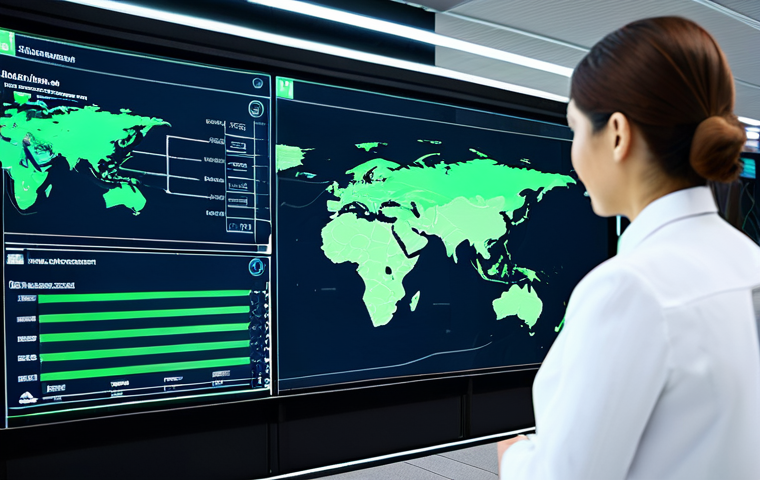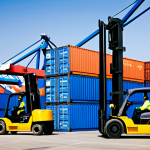Honestly, when you’re navigating the intricate world of international trade, it can often feel like you’re speaking a completely different language – even when it’s English.
I vividly recall those early days, wrestling with complex trade documentation, where a single misplaced comma or an obscure term could spiral into days of delays and mounting costs.
It’s not just about knowing the words; it’s about grasping the subtle nuances of trade English and the ever-shifting landscape of customs procedures. In today’s hyper-connected, yet increasingly regulated global market, staying ahead of emerging trends, from digital customs platforms to evolving compliance standards, is no longer optional.
Understanding these twin pillars isn’t just beneficial; it’s the bedrock of successful international commerce. Let’s dive deeper into it below.
Honestly, when you’re navigating the intricate world of international trade, it can often feel like you’re speaking a completely different language – even when it’s English.
I vividly recall those early days, wrestling with complex trade documentation, where a single misplaced comma or an obscure term could spiral into days of delays and mounting costs.
It’s not just about knowing the words; it’s about grasping the subtle nuances of trade English and the ever-shifting landscape of customs procedures. In today’s hyper-connected, yet increasingly regulated global market, staying ahead of emerging trends, from digital customs platforms to evolving compliance standards, is no longer optional.
Understanding these twin pillars isn’t just beneficial; it’s the bedrock of successful international commerce. Let’s dive deeper into it below.
The Unseen Language: Decoding Trade English’s Nuances

It’s easy to assume that because a document is in English, you automatically understand it. But believe me, the English of international trade is a beast of its own, often far removed from everyday conversation.
I once reviewed a seemingly straightforward Bill of Lading, only to find a clause tucked away that shifted liability for a significant portion of the transit to us, which wasn’t at all what we had agreed upon verbally.
This wasn’t a translation error; it was a deep dive into the specific, often antiquated, terminology that pervades contracts, shipping manifests, and customs declarations.
Every word, every phrase, carries immense legal and financial weight. It’s not just about vocabulary; it’s about context, precedent, and the often-unwritten rules understood by seasoned professionals.
Mastering this distinct dialect is paramount, as misinterpretations can lead to disputes, financial penalties, or even the rejection of goods at the border.
It’s a constant learning curve, requiring diligence and a healthy dose of skepticism when reviewing documents.
The Power of Precise Terminology in Contracts
When you’re dealing with international contracts, the devil isn’t just in the details; it’s in the very specific, often archaic, language used to describe obligations, liabilities, and terms.
I’ve personally seen deals crumble or turn sour because one party interpreted a phrase like “reasonable efforts” differently from the other, leading to lengthy and costly legal battles.
This isn’t about casual conversation; it’s about a highly specialized lexicon where words like “indemnify,” “heretofore,” “notwithstanding,” and “force majeure” are not mere jargon but critical components that define legal responsibilities.
Understanding the precise legal and commercial implications of each term, rather than assuming a common English meaning, is non-negotiable. Furthermore, specific trade terms, often rooted in centuries of commercial practice, dictate who pays for what, when, and where responsibilities shift.
This level of precision is what separates a watertight agreement from a legal nightmare.
Mastering Incoterms: The Global Language of Delivery
If there’s one area where precise English absolutely, unequivocally matters, it’s with Incoterms. These aren’t just acronyms; they are globally recognized rules that define the responsibilities of sellers and buyers for the delivery of goods under sales contracts.
I recall a situation early in my career where we almost lost a substantial amount of money because we misinterpreted an EXW (Ex Works) agreement, thinking the buyer would handle all export customs.
Turns out, under that specific Incoterm, we, as the seller, were still responsible for making the goods available at our premises, but the buyer bore almost all the risk and cost from that point onward, including the export clearance.
A simple misunderstanding of the subtle distinctions between FOB (Free on Board) and CIF (Cost, Insurance, and Freight), for instance, can drastically alter your profit margins or expose you to unforeseen risks.
Understanding which party is responsible for costs, risks, and tasks like export/import clearance and insurance is fundamental to preventing costly errors and ensuring smooth transactions.
Navigating the Digital Shift: Modernizing Customs Procedures
The days of mountains of paper forms and endless physical queues at customs offices are, thankfully, becoming a distant memory for many. The world of customs is rapidly digitizing, driven by a global push for greater efficiency, transparency, and security.
I remember the sheer frustration of a shipment being held up because one piece of paper was missing or incorrectly stamped; now, a single digital error can create the same bottleneck, but the process of correction is often far more streamlined, provided you’re on top of the technology.
This isn’t just about faster processing; it’s about a complete overhaul of how goods move across borders, impacting everything from compliance to supply chain visibility.
Embracing digital platforms and understanding their intricate requirements is no longer a competitive advantage; it’s a basic operational necessity.
The Rise of E-Customs Platforms and Single Windows
When governments started rolling out “single window” systems for customs, it felt like a breath of fresh air. Instead of submitting the same information multiple times to different agencies, we could upload everything once to a centralized digital portal.
This dramatically reduces paperwork and speeds up processing. For example, in the UK, the Customs Declaration Service (CDS) replaced the older CHIEF system, requiring a whole new learning curve for traders.
While initially daunting, mastering these platforms is crucial. They are designed to streamline the declaration process, from duty calculations to permit applications, ensuring that all necessary data is captured electronically and instantly verified.
My experience has been that those who invest time in training their teams to competently use these platforms see significantly fewer delays and far greater compliance, saving countless hours and avoiding hefty fines.
Leveraging Data Analytics for Predictive Compliance
Beyond just submitting declarations, the digital transformation in customs opens up incredible opportunities for data analysis. By consistently feeding accurate data into your systems and the customs platforms, you can start identifying patterns, predicting potential bottlenecks, and proactively addressing compliance risks.
I’ve worked with companies that, by analyzing their past customs declarations and audit outcomes, were able to identify common errors, train their staff more effectively, and even optimize their product classifications to ensure smoother passage.
This isn’t just about being reactive to customs queries; it’s about using the wealth of digital information to forecast, strategize, and build a more resilient and compliant supply chain.
It’s truly empowering to see how data, properly harnessed, can transform what was once a purely administrative function into a strategic asset.
Compliance Conundrums: Navigating Ever-Evolving Global Regulations
The regulatory landscape of international trade feels like quicksand – constantly shifting and always ready to pull you under if you’re not paying attention.
One minute, you’re compliant, the next, a new tariff is introduced, a sanctions list updated, or a product standard revised, and suddenly your entire operation is at risk.
I’ve witnessed firsthand the devastation caused by non-compliance, from goods being seized at the border to exorbitant fines that cripple businesses. It’s not enough to simply understand the rules of today; you must develop a robust system for monitoring, interpreting, and adapting to the rules of tomorrow.
This requires a dedicated effort, often involving specialized software and expert consultation, to ensure that your operations remain within the ever-tightening boundaries of global trade law.
Understanding Sanctions and Export Controls
One of the most complex and high-stakes areas of compliance is navigating international sanctions and export controls. The geopolitical landscape means that lists of sanctioned entities, individuals, and even specific technologies are constantly changing.
I remember a particularly stressful period when a key component we sourced for a product was suddenly caught under new export restrictions due to its potential dual-use capabilities.
This required an immediate scramble to find alternative suppliers and re-evaluate our entire supply chain for that product. Ignorance is absolutely no defense here; penalties for violations can be severe, including massive fines and criminal charges.
It’s crucial to implement rigorous screening processes for all parties involved in a transaction – customers, suppliers, freight forwarders – and to stay abreast of updates from bodies like the Office of Foreign Assets Control (OFAC) in the U.S.
or the UK’s Office of Financial Sanctions Implementation (OFSI).
Product Classification and Standards Compliance
Beyond who you trade with, *what* you trade is equally regulated. Correctly classifying your products using Harmonized System (HS) codes is the bedrock of accurate duty assessment and regulatory compliance.
I’ve found that even a slight misclassification, perhaps classifying a “smartphone case” as simply “plastic goods” rather than a specific “accessory for telecommunication apparatus,” can lead to incorrect duty payments, delays, and penalties.
Furthermore, products must often meet specific technical, safety, or environmental standards in the destination country. This could involve everything from CE marking for goods entering the European Union to specific electrical certifications for items sold in North America.
Ensuring your products meet these varied and often complex standards *before* they ship is critical to avoid rejection at customs and costly recalls.
Mastering Documentation: Your Passport to Seamless Trade
If international trade had a universal language, it would be documentation. From the commercial invoice to the bill of lading, the packing list to the certificate of origin, each document tells a crucial part of the story of your goods.
I’ve learned, sometimes the hard way, that even a tiny discrepancy – a typo in the weight, a missing signature, or an incorrect commodity code – can bring an entire shipment to a screeching halt.
These pieces of paper (or digital files) aren’t just administrative burdens; they are the legal and commercial proof of your transaction, essential for customs clearance, payment processing, and dispute resolution.
Accuracy, completeness, and consistency across all documents are not just best practices; they are absolutely vital for smooth, efficient, and compliant global trade.
Key Documents and Their Critical Role
Understanding the purpose and requirements of each core trade document is foundational. Let’s take the commercial invoice, for example. It’s not just a bill; it’s the primary document customs officials use to assess duties and taxes.
Any discrepancy between the invoice, the packing list, and the bill of lading in terms of quantity, value, or description will flag your shipment immediately.
I’ve seen situations where a small typo in the unit price led to a dispute over duties that took weeks to resolve. The Bill of Lading, on the other hand, is both a contract of carriage and a title to the goods, meaning whoever holds it can claim the cargo.
Its accuracy is paramount. Similarly, a Certificate of Origin can determine eligibility for preferential duty rates under free trade agreements, directly impacting your costs and competitiveness.
Each document is a link in a chain; if one link is weak or missing, the entire chain breaks.
| Document Type | Primary Purpose | Common Issues to Avoid |
|---|---|---|
| Commercial Invoice | Declares goods’ value, quantity, and description for customs, payment. | Inconsistencies with packing list/B/L, incorrect value/currency, missing HS codes. |
| Bill of Lading (B/L) | Contract of carriage, receipt of goods, document of title. | Inaccurate consignee/shipper details, wrong port info, mismatch with actual cargo. |
| Packing List | Details contents of each package, weight, dimensions. | Discrepancies in item count or weight, unlisted items, incorrect package marking. |
| Certificate of Origin | Declares the country where goods were manufactured or produced. | Incorrect origin country, missing necessary stamps/signatures, expired certificate. |
Leveraging Digital Documentation Systems
While the documents themselves remain critical, the way we manage them has transformed. Many companies are now using sophisticated Electronic Data Interchange (EDI) systems or other digital platforms to generate, exchange, and store trade documentation.
This greatly reduces manual errors, speeds up transmission, and improves data accuracy across the supply chain. I’ve personally experienced the relief of having a system that auto-populates fields based on previous shipments and validates data against pre-set rules, catching potential errors before they even leave your desk.
This shift to digital isn’t just about going paperless; it’s about building an integrated, auditable, and highly efficient documentation workflow that minimizes risk and accelerates customs clearance.
Proactive Problem-Solving: Mitigating Trade Disputes and Delays
Even with the most meticulous planning and the deepest understanding of trade English and customs, issues will inevitably arise in international trade.
The unexpected delay, the customs query, the product recall – these are not just hypothetical scenarios; they are the realities of moving goods across borders.
What truly separates successful traders from those who constantly struggle isn’t the absence of problems, but the ability to anticipate, react swiftly, and resolve them effectively.
I’ve learned that having robust protocols for communication, a clear escalation path, and a network of reliable partners can turn a potential disaster into a minor setback.
It’s about being proactive in identifying risks and having a well-rehearsed plan for when the unexpected happens.
Anticipating and Addressing Customs Holds
One of the most frustrating experiences in international trade is a customs hold. Your goods are stuck, demurrage charges are accumulating, and your client is waiting.
I’ve had my share of these, and what I’ve learned is that the key is early detection and rapid response. Often, a customs hold is triggered by something simple – a missing document, a vague product description, or a random inspection.
Building strong relationships with your customs broker and freight forwarder is invaluable here. They are your eyes and ears on the ground and can often get early warnings or insights into the reason for the hold.
Having a pre-defined checklist of required information and a clear point person for communicating with customs officials can significantly reduce the duration and cost of these unwelcome delays.
Effective Communication in Discrepancy Resolution
When a discrepancy arises, whether it’s a quantity short-shipment or a damaged product, effective communication is paramount. It’s not just about pointing fingers; it’s about quickly and clearly conveying the issue, providing supporting documentation (photos, inspection reports), and proposing solutions.
I remember a time when a consignment arrived with a noticeable number of damaged items. Instead of immediately escalating, we documented everything meticulously, sent a concise report with photographic evidence to the supplier, and proposed a partial credit rather than a full return, which was far more efficient for both parties.
This open, solution-oriented dialogue, conducted in clear, unambiguous English, is essential for preserving business relationships and reaching amicable resolutions without resorting to lengthy and costly legal battles.
Building Bridges: Collaborative Approaches in Global Trade
In an increasingly complex global trade environment, no single entity can navigate the intricacies alone. What I’ve come to truly appreciate is the immense value of collaboration – with your supply chain partners, your customers, and even government agencies.
My most successful ventures in international trade haven’t been about operating in isolation, but about forging strong, transparent relationships based on mutual trust and shared understanding.
This extends beyond mere transactions; it’s about creating an ecosystem where information flows freely, problems are tackled jointly, and innovations are embraced collectively.
It’s a move away from adversarial dynamics towards a more integrated and symbiotic approach that ultimately benefits everyone involved.
Cultivating Strong Relationships with Trade Partners
Your success in international trade is intrinsically linked to the strength of your relationships with your suppliers, freight forwarders, customs brokers, and even your banks.
I vividly remember a critical shipment that was stuck due to an unexpected port strike. Our freight forwarder, with whom we had a long-standing, trusting relationship, immediately leveraged their network to find an alternative route and carrier, diverting the cargo to a different port and salvaging the delivery timeline.
This kind of proactive problem-solving only happens when you’ve invested in building genuine partnerships, not just transactional relationships. Regular communication, shared goals, and a willingness to understand each other’s challenges foster a level of collaboration that is invaluable when navigating the unpredictable currents of global commerce.
The Value of Industry Associations and Networking
Beyond your immediate partners, connecting with broader industry associations and professional networks can provide an invaluable source of knowledge, support, and collective influence.
Attending trade shows, participating in webinars, and joining online forums has, for me, been instrumental in staying current on emerging trends, best practices, and regulatory changes.
It’s where I’ve heard first-hand accounts of new digital customs initiatives, learned about upcoming compliance challenges from peers, and even found solutions to specific trade hurdles by tapping into the collective experience of the community.
These networks aren’t just for job hunting; they are vibrant ecosystems of shared expertise that can help you anticipate shifts, benchmark your practices, and even advocate for industry needs with policymakers, truly shaping the future of global trade.
Wrapping Up
As we’ve journeyed through the intricacies of global commerce, it’s clear that mastering international trade is an ongoing expedition, not a destination. From the nuanced language of trade English and the critical role of Incoterms to the accelerating pace of digital customs and the ever-shifting sands of global compliance, success hinges on diligence, adaptability, and an unyielding commitment to precision. Embrace these pillars, not as obstacles, but as opportunities to build a more robust, efficient, and ultimately more profitable international trade operation. Your proactive approach to understanding and navigating these complexities will undoubtedly set you apart in the global marketplace.
Useful Resources
1. ICC Official Incoterms® Rules: For the definitive guide on Incoterms 2020, always refer to the International Chamber of Commerce (ICC) official publications. These rules are globally recognized and essential for clarity in trade contracts.
2. Government Customs Websites: Stay updated on import/export regulations by regularly checking official customs websites like U.S. Customs and Border Protection (CBP) or Her Majesty’s Revenue and Customs (HMRC) in the UK. They provide the most accurate and current information.
3. World Customs Organization (WCO) HS Code Search: Use the WCO’s resources or official government tariff look-up tools to ensure accurate Harmonized System (HS) code classification for your products, which is crucial for duty assessment and compliance.
4. Industry Trade Associations: Join reputable trade associations such as the American Association of Exporters and Importers (AAEI) or local Chambers of Commerce. These networks offer invaluable insights, training, and advocacy on trade matters.
5. Trade Compliance Software Providers: Explore modern trade compliance and global trade management (GTM) software solutions. Tools from companies like SAP, Oracle, or smaller specialized providers can automate documentation, screening, and regulatory updates, significantly streamlining operations.
Key Takeaways
Navigating international trade requires a multi-faceted approach. Prioritize mastering the precise terminology of trade English and Incoterms to prevent costly misinterpretations. Embrace digital customs platforms and leverage data analytics for efficiency and predictive compliance. Maintain vigilant oversight of global regulations, particularly sanctions and product standards, to avoid severe penalties. Ensure impeccable accuracy in all trade documentation, as it’s your primary proof and passport for goods movement. Finally, cultivate strong relationships with all trade partners and actively participate in industry networks to foster collaboration and proactive problem-solving.
Frequently Asked Questions (FAQ) 📖
Q: You mentioned the ‘subtle nuances of trade English’ and how a single misplaced comma or obscure term could spiral into days of delays and mounting costs. Can you share a real-world example of such a misstep and what businesses can do to avoid these costly mistakes?
A: Oh, absolutely! I still vividly remember a situation with a shipment of specialty machinery destined for a client in the Midwest. The Bill of Lading, which seemed perfectly fine to the inexperienced eye, had a tiny typo – a ‘c’ instead of an ‘e’ in “consignee’s address,” leading to a completely non-existent street number.
You wouldn’t believe the headache. The freight sat for five days at the port in Los Angeles, racking up demurrage fees and frustrating everyone involved, all because of one single letter.
My client was furious, and I was pulling my hair out trying to get it sorted. What did we learn? First, double, triple, then quadruple-check every single document.
Seriously, have multiple sets of eyes, especially someone who’s been in the trenches for years. Second, invest in specialized training for your team, not just general English, but trade English – understanding Incoterms, customs nomenclature, and common clauses.
And honestly, don’t be afraid to lean heavily on your customs broker. They’re worth their weight in gold; they speak this language fluently and can often catch these things before they become nightmares.
Q: The global market feels more regulated than ever, with customs procedures constantly evolving. What’s one of the biggest changes you’ve personally witnessed in customs over the past few years, and how are successful businesses adapting?
A: For me, one of the most significant shifts has been the relentless march towards digitalization and pre-arrival data requirements. It used to be much more about paper and physical inspections, but now, it’s all about providing precise, granular data before the goods even leave the port of origin.
I’ve seen firsthand how a single, minor discrepancy in an advanced manifest declaration can trigger an immediate “do not load” message, halting an entire shipment before it even gets on the vessel.
It’s a huge shift from a reactive to a proactive compliance model. Successful businesses aren’t just reacting to these changes; they’re embracing them.
They’re investing heavily in robust Enterprise Resource Planning (ERP) systems that integrate their inventory, sales, and shipping data seamlessly, ensuring data consistency across all documents.
They’re also building stronger relationships with their technology providers and, crucially, engaging early with customs authorities through programs like the Authorized Economic Operator (AEO) status.
It means more upfront work, but it pays off in smoother clearances and fewer frustrating delays down the line.
Q: Beyond just documentation and procedures, what’s often overlooked when trying to build a truly ‘successful international commerce’ operation in today’s environment, and what’s your top piece of advice for newcomers?
A: This is a fantastic question, because it’s precisely where many stumble. What’s often overlooked isn’t the paper or the process, but the human element and the cultural nuances that underpin global trade.
You can have perfect documentation, but if you don’t understand the unwritten rules of business in a particular country – whether it’s the importance of face-to-face meetings, the subtle ways negotiations are conducted, or the value placed on long-term relationships over quick deals – you’re setting yourself up for failure.
I once saw a promising deal fall apart not because of contract terms, but because one party inadvertently offended the other by rushing a decision, a clear cultural misstep.
My top advice for newcomers? Be relentlessly curious about cultures and build trust above all else. Don’t just focus on the numbers; invest time in understanding your partners, their values, and their way of doing business.
Attend industry events, read up on international etiquette, and genuinely listen. And here’s a big one: always have a contingency plan (or three). The global landscape is volatile; expect the unexpected, and be ready to pivot.
Resilience and strong, trusting relationships will be your true north.
📚 References
Wikipedia Encyclopedia
구글 검색 결과
구글 검색 결과
구글 검색 결과
구글 검색 결과
구글 검색 결과






